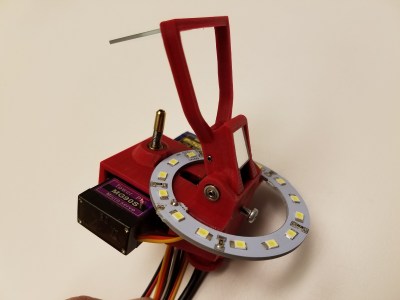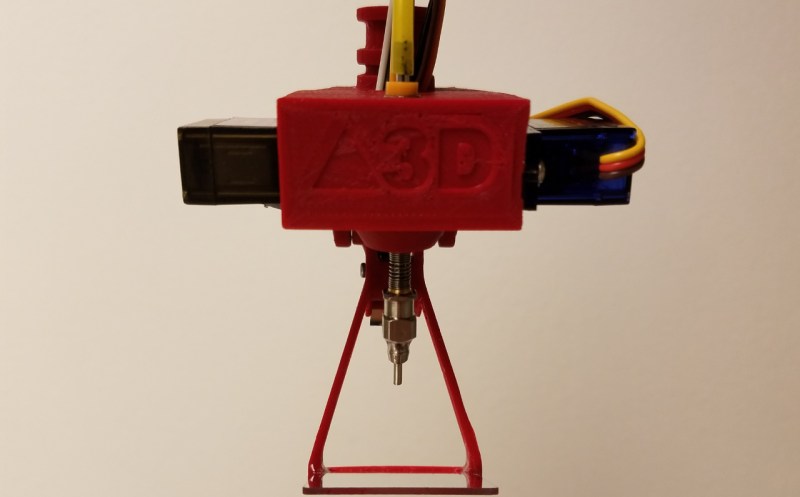For his Hackaday prize entry, [Daren Schwenke] is creating an open-source pick-and-place head for a 3D printer which, is itself, mostly 3D printable. Some serious elbow grease has gone into the design of this, and it shows.
The really neat part of this project comes in the imaging of the part being placed. The aim is to image the part whilst it’s being moved, using a series of mirrors which swing out beneath the head. A Raspberry Pi camera is used to grab the photos, an LED halo provides consistent lighting, and whilst it looks like OpenPnP may have to be modified slightly to make this work, it will certainly be impressive to see.

Two 9g hobby servos are used: one to swing out the mirrors (taking 0.19 seconds) and one to rotate the part to the correct orientation (geared 2:1 to allow 360 degrees part rotation). Altogether the head weighs 59 grams – lighter than an E3D v6.
In order to bring this project to its current state, [Daren] has had to perform some auxiliary hacks. The first was an aquarium to vacuum pump conversion – by switching around the valves and performing some other minor mods, [Daren] was able to produce a vacuum of 231mbar. The second was hacking a two-way solenoid valve from a coffee machine into a three-way unit. As [Daren] says, three-way valves are not expensive, but “a part in hand is worth two on Alibaba.”



















I have been thinking about getting suction from an aquarium pump. I wanted to be able to re-use the same pump for either suction or blowing without taking it apart. My plan is to enclose the pump in an air-tight container. The container would have two hose connections on it. One would connect to the output of the pump. The other would just be open to the inside of the container. Of course there would have to be a hole for the power cord and that would have to be sealed air-tight around the cord.
The idea is that the air blown out the pump has to come from somewhere. It would evacuate the enclosure and then suck in through the open hose connection.
Is there any reason that will not work?
Provided you can seal it that should work, and you’ll get a vacuum reservoir to boot. In my case I just flipped one set of valves left the other one alone so I get vacuum and pressure out of the same pump.
I can’t really pinpoint the reasons, but from past experience I would guess that the relatively large volume of the (vacuum) container will probably cause problems. I suspect it has to do with the fact that air is compressible, and the volume your trying to hold is large relative to the pump’s flow rate.
Also, the pump being inside the container could change the local pressure due to pump temperature.
It might be worth trying though. Maybe my experience (about 25 years ago) has nothing to do with what you’re attempting.
Constant pressure (vacuum) valve to the rescue ?
I tried that and found that I was unable to seal the box. I used 3/4 inch high grade plywood, coated the interior in a thick coat of epoxy, sealed the wide overlap of the cover with silicone sealant and found that no matter what else I did the tiny amount of leakage overwhelmed the minuscule pumping action.
Much better is to get a blower (not a fan) which is what vacuum cleaners use. There are small versions available for cooling electronics. They depend on centrifugal acceleration to push the air out rather than depending on developing lift which means they can still work to maintain a pressure delta under conditions that would cause aerodynamic stall.
Probably easier to just buy a second aquarium pump.
Heat build up if you run the pump inside the vacuum for very long?
A vacuum Reservoir is not always a good idea. They’re great for initiating the grab or starting an initial vacuum, but if you want a hard vacuum it’s often best to take them out of the situation after the initial start.